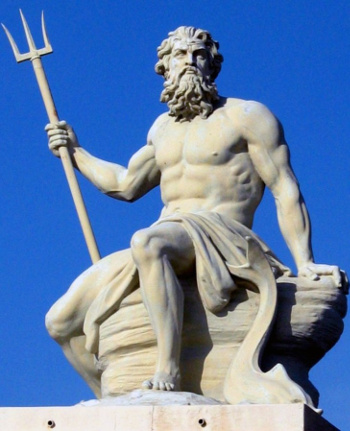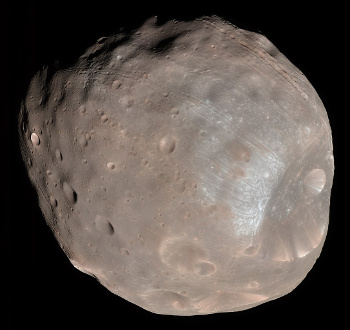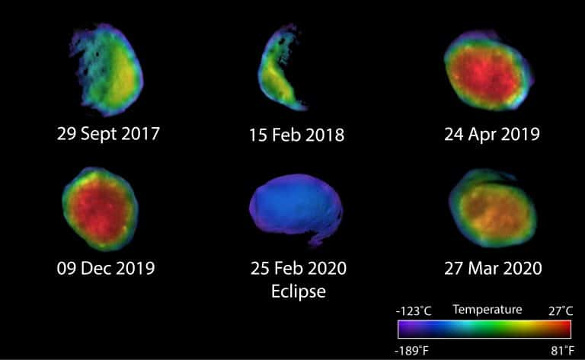Martian Moon Phobos
July 27, 2020
The
planets visible with the
unaided eye are still known today by the names of
mythological deities given them in
antiquity.
Astronomers have kept this
tradition in a similar naming of planets discovered
telescopically after that time, as shown in the table.
Pluto was demoted from full planet status in 2006, after many similar
dwarf planets were discovered. I've included it in the table, since it was a planet from 1930 until that year.
| Name |
Namesake |
| Mercury |
Mercury was the messenger of the Roman gods, and also the guide of souls to the underworld. |
| Venus |
Venus is the Roman goddess of beauty, love, and desire. |
| Mars |
Mars was the Roman god of war. The adjective, martial, derives from his name. |
| Jupiter |
Jupiter is the king of the Roman gods, and also the god of the sky and thunder. He is often depicted clutching lightning bolts. |
| Saturn |
The Roman god, Saturn, was the father of Jupiter, Neptune, and Pluto. |
| Uranus |
The Greek god, Uranus, was the father of Saturn and was at one time the king of the gods. |
| Neptune |
Neptune was the the Roman god of the sea. |
| Pluto |
Pluto was the Roman god of the underworld. |
While the
Earth and our
Moon are known today by their common names, the
Greeks associated the Earth with the goddess,
Gaia (Roman goddess,
Terra, from which so many Earthy adjectives derive). The Moon was associated with the Greek goddess,
Selene, and the Roman goddess,
Luna, from which we get the adjective,
lunar. Selene was
romantically involved with
Zeus, as were so many others, as can be read below.
It's estimated that there are more than a million
asteroids in the
main asteroid belt between Mars and Jupiter. A few of the larger of these have been given traditional names, as listed in the table.
Many planets have moons, and many of these have
traditional names.
Planetary exploration with
spacecraft has revealed nearly eighty
moons of Jupiter, but quite a few of the earlier discovered moons have names based on Greek mythology, as listed in the table.

Our tradition of naming Solar System bodies after mythological beings was nearly defeated by Galileo (1564-1642), who discovered the first four moons of Jupiter using the recently invented telescope. In order to secure funding from the de' Medici family, he named these moons the "Medician Stars" in his book, Sidereus Nuncius ("Starry Messenger"), published March, 1610, less than two months after his discovery.
Fortunately, Simon Marius, who discovered the moons independently at about the same time as Galileo, gave them our now common names in 1614 at the suggestion of Johannes Kepler (1571-1630).
(A composite image of the Galilean moons, Io, Europa, Ganymede, and Callisto. Io and Ganymede were imaged by NASA's Galileo spacecraft in June, 1996, while Europa and Callisto were imaged somewhat later. NASA/JPL/DLR image via Wikimedia Commons.)
Exploratory spacecraft have revealed that Saturn has many more
moons than Jupiter, seven of which have names derived from Greek and Roman mythology.
The naming of the
The moons of Uranus departed from tradition, since they are named for
literary characters. Although there is a
Cupid, the name comes from a character in
Shakespeare's play,
Timon of Athens, and not the
Cupid who was the son of Venus and Mars. The planet, Neptune, however, has many of its satellites named after mythological creatures of the sea, as seen in the following table.

A sculpture of the Greek god of the sea, Poseidon (Neptune in Roman mythology), at the Port of Copenhagen.
The word "trident" comes from the combination of Latin words for "three" and "teeth," as in the weapon in this sculpture. Homer's Iliad, however, uses the word τρíαινα for this, a word that just means "threefold." However, in the context, this type of fishing spear must have been implied.
(Photo by Hans Andersen, via Wikimedia Commons.)
| Name |
Namesake |
| Naiad |
The Naiads were nymphs who presiding over springs, brooks and other fresh water bodies. |
| Thalassa |
Thalassa was a sea goddess |
| Despina |
The nymph, Despoina, was a daughter of the ocean god, Poseidon |
| Galatea |
Galatea was a Nereid. Her name translates as she who is milk-white |
| Larissa |
Larissa was a nymph lover of the sea god, Poseidon, who fathered three sons by her |
| Hippocamp |
The Hippocamp is a chimera that's half horse and half fish |
| Proteus |
Proteus was a prophetic sea god who changed his shape to avoid capture. His name gives rise to the adjective, protean |
| Triton |
Triton was a son of Poseidon, and he was represented as a merman who blew a conch shell like a trumpet |
| Nereid |
The Nereids were sea-nymph attendants to Poseidon |
| Halimede |
Halimede was one of the many Nereids |
| Sao |
Sao was a Nereid associated with sailing |
| Laomedeia |
Laomedeia was another Nereid |
| Psamathe |
The Nereid, Psamathe, was the goddess of sand beaches and wife of Proteus |
| Neso |
Neso was another Nereid |
In the past, Pluto was thought to be much larger than it actually is, since telescopic images combined the planet with its large and close satellite,
Charon. Planetary exploration revealed Charon and four other
moons of Pluto, all named for creatures associated with the god of the underworld.
While the
gas giant planets have many moons,
terrestrial planets have few, if any. Earth has our one Moon, Mercury and Venus have none, and Mars has just two. The two
moons of Mars,
Phobos and
Deimos, are quite unlike Earth's Moon. They are small and irregularly shaped. Phobos has a
diameter of just 22.2
kilometers (13.8
miles), and Deimos has a diameter of just 12.6 kilometers (7.8 miles).
Our Moon takes a
month to
orbit, while the orbital period of Phobos is just 7.66 hours, and that of Diemos is just 30.35 hours. In keeping with tradition, Phobos and Diemos were named after mythological beings associated with Mars (Greek god, Ares).
Phobos (fear) and
Deimos (dread) were the sons of Ares who accompanied him into
battle.
Since Phobos and Diemos are so small, they weren't discovered until 1877. The discovery was made by
Asaph Hall (1829-1907) of the
US Naval Observatory during a deliberate search for Martian moons. Like our own Moon, the Martian moons are
tidally locked, showing the same face towards their host planet. Since these moons are so unusual, their possible origin is still
controversial. They appear to be much like
carbonaceous C-type asteroids, so they might be captured asteroids. These moons could have
coalesced from an orbital
debris cloud after Mars formed, this debris cloud forming by a
collision of Mars with a
protoplanet.
In 2015, scientists from
NASA's Goddard Space Flight Center (Greenbelt, Maryland), found evidence that the long
grooves on the surface of Phobos, believed to be the result of the
impact that caused its main feature,
Stickney crater, are signs of
structural failure that will ultimately destroy this moon.[1] The impact that formed this crater was so powerful, it nearly shattered Phobos, and
modeling by the Goddard scientists indicates that the grooves resemble
stretching marks caused by
deformation from tidal forces.[1] It's thought that the interior of Phobos is just a
rubble pile that's barely
held together.[1] It's been determined that some grooves are younger than others, which is indicative of an ongoing process.[1]

A color image of Phobos, imaged by the High Resolution Imaging Science Experiment (HiRISE) camera on NASA's Mars Reconnaissance Orbiter, March 23, 2008. Stickney crater, with a diameter of 9 kilometers (5.6 miles), can be seen at the lower right.
(NASA/JPL-Caltech/University of Arizona image via Wikimedia Commons. Click for larger image.)
Christopher Edwards, an
assistant professor in the
Department of Astronomy and Planetary Science of
Northern Arizona University, and scientists at NASA’s
Jet Propulsion Laboratory and
Arizona State University, performed a recent
thermal imaging study of Phobos to help determine whether Phobos is a captured asteroid, or a fragment of Mars that was ejected by impact of a
meteorite.[2] They used the
Thermal Emission Imaging System (THEMIS) of the
Mars Odyssey orbiter to capture the images during the moon's different
phases.[2] The Mars Odyssey orbiter has been observing Mars for more than 18 years.[2] These images are a marked improvement over previous studies.[3]

Thermal images of Phobos during its different phases, waxing, waning and full. These include a December 9, 2019, image of Phobos at its maximum temperature (27 degrees Celsius), an image of February 25, 2020, in which Mars' shadow completely blocked sunlight from its surface (-123 degrees Celsius), and a March 27, 2020, image where Phobos was exiting an eclipse and just warming.[2]. (NASA/JPL-Caltech/ASU/NAU image from Northern Arizona University (NAU), also available here)
The thermal imaging revealed that the surface of Phobos is relatively uniform and composed of very
fine-grained, mostly
basaltic,
materials.[2] While these images don't provide a definitive answer to the question of Phobos' origin, they're an important piece of
evidence. The
Japanese Space Agency (JAXA) has planned a
Martian Moons Exploration (MMX) mission to Phobos and Diemos. MMX will land and collect samples from Phobos, and the thermal imaging study has provided
reconnaissance data for that mission.[2]
References:
- Elizabeth Zubritsky, "Mars' Moon Phobos is Slowly Falling Apart," NASA's Goddard Space Flight Center Press Release, November 10, 2015.
- NAU planetary scientist captures new images of Martian moon Phobos to help determine its origins, Northern Arizona University Press Release, June 3, 2020.
- Martian Moon Phobos in Thermal Infrared Images, NASA Jet Propulsion Laboratory Website, October 4, 2017.
Linked Keywords: Planet; naked eye; unaided eye; mythology; mythological; deity; deities; antiquity; astronomer; tradition; telescope; telescopic; telescopically; Pluto; dwarf planet; Mercury (planet); Mercury (mythology); courier; messenger; Ancient Rome; guide; soul; underworld; Venus; Venus (mythology); goddess; beauty; love; desire; Mars; Mars (mythology); god of war; adjective; marital; Jupiter; Jupiter (mythology); monarch; king; sky; thunder; thunderbolt; lightning bolt; Saturn; Saturn (mythology); father; Neptune (mythology); Pluto (mythology); Uranus; Uranus (mythology); Neptune; Neptune (mythology); sea; Earth; Moon; Ancient Greece; Greeks; Gaia; Terra (mythology); Selene; Luna (goddess); romance (love); romantic; romantically; Zeus; asteroid; asteroid belt; main asteroid belt; Ceres (dwarf planet); Ceres (mythology); agriculture; grain crop; cereal; 4 Vesta; Vesta (mythology); virginity; virgin; hearth; home; family; temple; Vestal Virgins; 2 Pallas; Pallas Athena; Athena; wisdom; handicraft; war; warfare; 10 Hygiea; Hygieia; health; hygiene; naming of moons with traditional names; Solar System exploration; planetary exploration; spacecraft; moons of Jupiter; Io (moon); Io (mythology); mortality; mortal; love; lover; Perseus; Europa (moon); Europa (consort of Zeus); woman; kidnapping; abduct; bull; Ganymede (moon); Ganymede (mythology); Homer; eagle; cup-bearer; Mount Olympus; Olympic; Callisto (moon); Callisto (mythology); nymph; rape; raped; Xena: Warrior Princess Callisto character; Hudson Leick; Metis (moon); Metis (mythology); Titans (mythology); wife; Adrastea (moon); Adrasteia (mythology); secrecy; secret; parenting; caregiver; infant; risk; danger; Cronus; Amalthea (moon); Amalthea (mythology); goat; herding; Thebe (moon); Thebe (Greek myth); queen consort; libido; sex drive; tradition; Solar System; mythology; mythological; Galileo Galilei (1564-1642); Galilean moons; first four moons of Jupiter; optical telescope; funding; House of Medici; de' Medici family; book; Sidereus Nuncius; Simon Marius; Johannes Kepler (1571-1630); compositing; composite image; Io (moon); Europa (moon); Ganymede (moon); Callisto (moon); NASA's Galileo spacecraft; Wikimedia Commons; moons of Saturn; Mimas (moon); Mimas (Giant); Giants; Enceladus; Enceladus (giant); Tethys (moon); Tethys (mythology); daughter; sibling; sister; Titans (mythology); mother; water deities; river gods; Oceanids; Dione (moon); Dione (mythology); Aphrodite; Rhea (moon); Rhea (mythology); Titan (moon); Titans (mythology); Iapetus (moon); Iapetus (mythology); Atlas (mythology); Prometheus; moons of Uranus; character (arts); literary character; Cupid (moon); William Shakespeare; play; Timon of Athens; Cupid; sculpture; Greek god of the sea; Poseidon; Neptune (mythology); Ancient Rome; mythology; Port of Copenhagen; Latin; weapon; Homer's Iliad; spearfishing; fishing spear; Hans Andersen; Naiad (moon); The Naiads; spring (hydrology); brook; fresh water; Thalassa (moon); Thalassa (mythology); Despina (moon); Despoina; Galatea (moon); Galatea (mythology); Larissa (moon); Larissa (mythology); Hippocamp (moon); Hippocamp; Chimera (mythology); horse; fish; Proteus (moon); Proteus; prophecy; prophetic; protean; Triton (moon); Triton (mythology); merman; conch shell; trumpet; Nereid (moon); Nereids; Halimede (moon); Sao (moon); sailing; Laomedeia; Psamathe (moon); Psamathe (Nereid); sand; beach; Neso (moon); Charon (moon); moons of Pluto; Charon; ferry; ferryman; river; Styx; Styx (moon); Nix (moon); Nyx; darkness; night; Kerberos (moon); Cerberus; dog; gate; Hydra (moon); Lernaean Hydra; snake; serpent; security guard; Lerna; gas giant planet; terrestrial planet; moons of Mars; Phobos (moon); Deimos (moon); diameter; kilometer; mile; month; orbit; Phobos (mythology); Deimos (deity); battle; Asaph Hall (1829-1907); United States Naval Observatory; tidal locking; tidally locked; controversy; controversial; carbonaceous C-type asteroid; coalescence (physics); coalesce; debris; collision; protoplanet; NASA; Goddard Space Flight Center (Greenbelt, Maryland); groove (engineering); impact event; Stickney crater; structural integrity and failure; computer simulation; modeling; stretching; deformation (engineering); rubble; Mohr-Coulomb theory; High Resolution Imaging Science Experiment (HiRISE) camera; Mars Reconnaissance Orbiter; Christopher Edwards; assistant professor; Department of Astronomy and Planetary Science; Northern Arizona University; Jet Propulsion Laboratory; Arizona State University; thermography; thermal imaging; meteorite; Thermal Emission Imaging System (THEMIS); Mars Odyssey orbiter; lunar phase; waxing, waning and full; temperature; Celsius; shadow; sunlight; eclipse; crystallite; fine-grain; basalt; basaltic; material; evidence; Japanese Space Agency (JAXA); Martian Moons Exploration (MMX); reconnaissance.